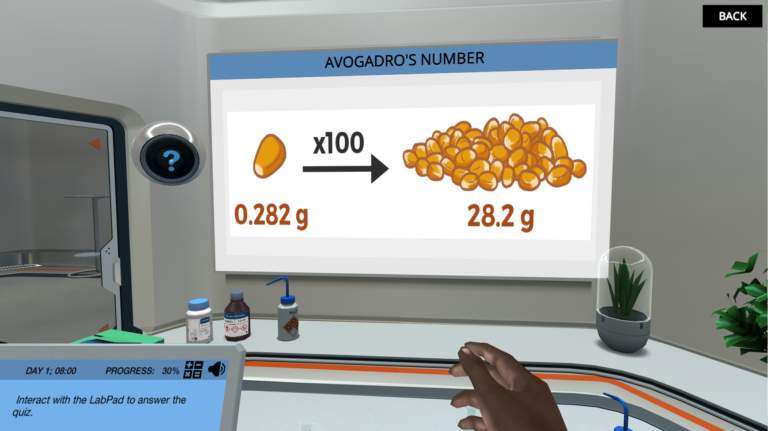Heading 1
Heading 2
Heading 3
Heading 4
Heading 5
Heading 6
Lorem ipsum dolor sit amet, consectetur adipiscing elit, sed do eiusmod tempor incididunt ut labore et dolore magna aliqua. Ut enim ad minim veniam, quis nostrud exercitation ullamco laboris nisi ut aliquip ex ea commodo consequat. Duis aute irure dolor in reprehenderit in voluptate velit esse cillum dolore eu fugiat nulla pariatur.
Block quote
Ordered list
- Item 1
- Item 2
- Item 3
Unordered list
- Item A
- Item B
- Item C
Bold text
Emphasis
Superscript
Subscript
About This Simulation
Define and calculate key molecular parameters based on Avogadro’s Law and learn about the relationship between mass, molecular weight, and numbers of atoms or molecules!
Learning Objectives
- Explain relationship between mass, molecular weight, and numbers of atoms or molecules
- Perform conversion and derivations calculations using key molecular quantity parameters
- Define Avogadro’s number and describe the mole quantification of matter
About This Simulation
Lab Techniques
Related Standards
- HS-PS1-7
- PS1.A-E2
- Chemistry 1.1 Moles and Molar Mass
- Chemistry 4.5 Stoichiometry
- Chemistry 1
- Chemistry 1.2
Learn More About This Simulation
This short, targeted simulation is adapted from the full-length “Stoichiometric Calculations” simulation.
How many moles of sand grains has the Sahara desert? What is the only equation you´ll ever need in chemistry? The short stoichiometry simulation will help you answer those questions! Follow the footsteps of great chemists and learn about key molecular parameters based on one and only star of chemistry calculations: Avogadro’s Law!
Concept mole and Avogadro’s Law:
Your first mission in this short simulation is to familiarize yourself with the concept of mole and the way of counting molecules of substances using the one and only Avogadro’s Law. You will learn how to convert huge numbers of particles into handy Avogadro’s number, extensively used by all chemists around the world!
Chemical units relationship:
Next, you will explore the relationship between mass, molecular weight, and number of atoms. This magical equation will enable you to perform derivations of molecular quantity parameters for various chemical substances. You will feel like Marie Curie analysing chemical dependencies of chemicals in her french laboratory!
Use theoretical knowledge in practice:
When you learn about those concepts of Avogadro’s number and unit conversion of molecular quantity parameters, jump to the second stoichiometry short simulation “Stoichiometry: Gravimetric Analysis” to use this theoretical knowledge in practice and discover the name of the unknown chemical in the Labster chemistry lab!
For Science Programs Providing a Learning Advantage
Boost STEM Pass Rates
Boost Learning with Fun
75% of students show high engagement and improved grades with Labster
Discover Simulations That Match Your Syllabus
Easily bolster your learning objectives with relevant, interactive content
Place Students in the Shoes of Real Scientists
Practice a lab procedure or visualize theory through narrative-driven scenarios


FAQs
Find answers to frequently asked questions.
Heading 1
Heading 2
Heading 3
Heading 4
Heading 5
Heading 6
Lorem ipsum dolor sit amet, consectetur adipiscing elit, sed do eiusmod tempor incididunt ut labore et dolore magna aliqua. Ut enim ad minim veniam, quis nostrud exercitation ullamco laboris nisi ut aliquip ex ea commodo consequat. Duis aute irure dolor in reprehenderit in voluptate velit esse cillum dolore eu fugiat nulla pariatur.
Block quote
Ordered list
- Item 1
- Item 2
- Item 3
Unordered list
- Item A
- Item B
- Item C
Bold text
Emphasis
Superscript
Subscript
A Labster virtual lab is an interactive, multimedia assignment that students access right from their computers. Many Labster virtual labs prepare students for success in college by introducing foundational knowledge using multimedia visualizations that make it easier to understand complex concepts. Other Labster virtual labs prepare learners for careers in STEM labs by giving them realistic practice on lab techniques and procedures.
Labster’s virtual lab simulations are created by scientists and designed to maximize engagement and interactivity. Unlike watching a video or reading a textbook, Labster virtual labs are interactive. To make progress, students must think critically and solve a real-world problem. We believe that learning by doing makes STEM stick.
Yes, Labster is compatible with all major LMS (Learning Management Systems) including Blackboard, Canvas, D2L, Moodle, and many others. Students can access Labster like any other assignment. If your institution does not choose an LMS integration, students will log into Labster’s Course Manager once they have an account created. Your institution will decide which is the best access method.
Labster is available for purchase by instructors, faculty, and administrators at education institutions. Purchasing our starter package, Labster Explorer, can be done using a credit card if you are located in the USA, Canada, or Mexico. If you are outside of North America or are choosing a higher plan, please speak with a Labster sales representative. Compare plans.
Labster supports a wide range of STEM courses at the high school, college, and university level across fields in biology, chemistry, physics, and health sciences. You can identify topics for your courses by searching our Content Catalog.















